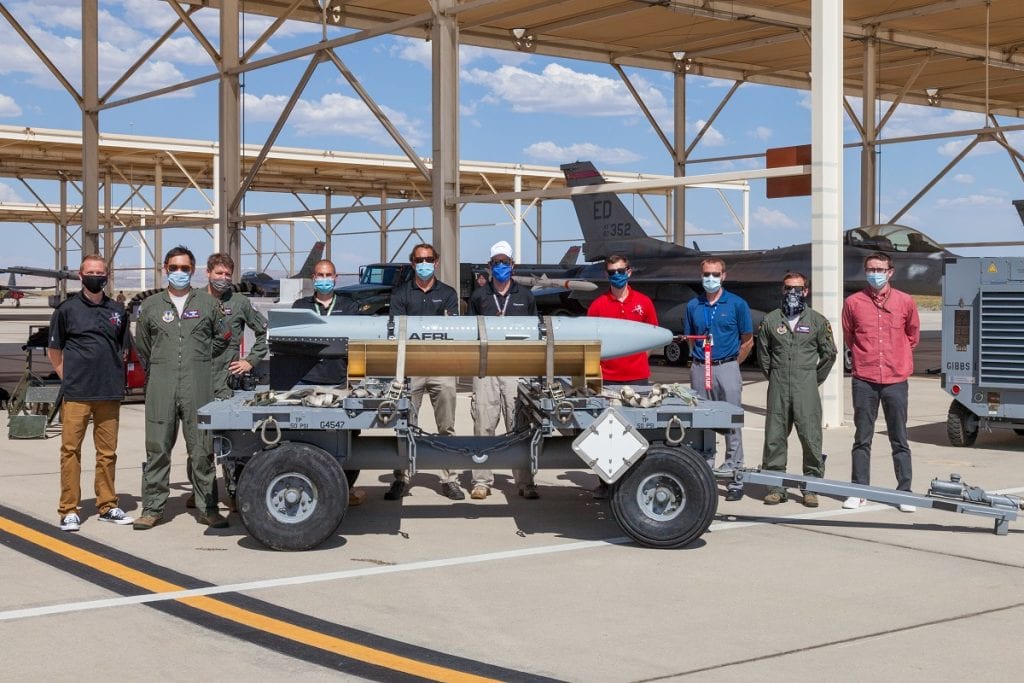
Members of the Gray Wolf test team and 416th Flight Test Squadron pose at Edwards AFB, Calif. after a captive-carry flight test of the Gray Wolf cruise missile prototype on June 9th last year (U.S. Air Force)
Digital twins look to be a new hallmark of U.S. Air Force weapons systems to improve their design, performance, and sustainment.
NASA pioneered the use of twins in the 1960s during the Apollo moon missions by building a full-size replica of the Apollo capsule. That effort continues today, as NASA uses twins of the Perseverance Mars Rover and its Earth-bound sibling, the Operational Perseverance Twin for Integration of Mechanisms and Instruments Sent to Mars. Former Air Force Acquisition Chief Will Roper often cited Formula One race car teams, which use sensors on the cars and remotely operated digital twins to make hundreds of changes to cars during races.
“Here at Eglin Air Force Base, we’re building a modern type of twin for the Air Force–a digital twin of Air Force weapons and assets,” James Sumpter, senior scientist and program manager for the Weapons Digital Enterprise/Digital Twin Lab of the Air Force Research Laboratory’s (AFRL) munitions directorate at Eglin AFB, Fla. told the AFRL Inspire summit on April 28.
“Today’s digital twins talk to their physical counterparts–a bi-directional conversation exchanging sensor data, predictions, and updates,” he said. “We leverage this dialogue to continuously and iteratively update our weapons systems. It’s a constantly improving feedback loop that we can apply throughout the life of a weapon.”
Sumpter cited three reasons for the Air Force to invest in digital twin technologies to apply to weapons system design, development, and sustainment: technology convergence in the physical and digital realms, the promise of data sharing to improve weapon performance, and the need to adapt in the evolution of peer threats.
“The power of the twin comes from turning data into information,” Sumter said. “A tremendous amount of data is generated for our weapons systems throughout their life cycle. This data is stored on servers and work stations housed in the secure areas of buildings–largely inaccessible and often effectively lost. Accessing and analyzing this data across a patchwork of formats and proprietary models can be time consuming…Digital twins change the paradigm [and] empower us to make intelligent sense of complex physical systems by making data available, connected, and organized–accessible through secure, cloud-enabled environments–and underpinned by standards and authoritative sources of truth.”
Air Force Chief of Staff Gen. Charles Q. Brown’s Accelerate Change or Lose vision posited the need for the service to adapt rapidly to likely threats, including supply chain disruption attempts by adversaries.
Sumter said that digital twins will permit such adaptation.
“Peer adversary systems are sophisticated and evolving,” he said. “Logistics and supply chains will be challenged. Every gallon of gas will matter. Every bullet, every bomb, every missile will matter. Every tactical strike that we cannot plan and assess with the utmost accuracy and optimization will, by its very nature, threaten the entire mission chain–prolonging the conflict, requiring more supplies, and putting more people at risk more often. To adapt and pivot for the future fight, we need to shift from telling our warfighter, ‘You got what you got,’ and design and develop the capability to rapidly evolve what you got into what you need. Digital twins enable us to do just this, leveraging technology as the whetstone to sharpen the tip of the spear.”
Digital twins may aid in weapons system sustainment through the use of condition-based monitoring and predictive maintenance algorithms, as continual monitoring of temperatures, shocks and vibrations on weapons systems would allow mechanics to fix the systems before they break. AFRL is also building next-generation digital twins to speed decision support for the planning of missions and their execution and for tactics optimization.
Last fall, Roper held out the possibility that the service would soon announce an e-series, digitally engineered weapon to follow the Air Force designation of the eT-7A training aircraft as the service’s first e-series platform and aircraft.
While the Air Force has yet to disclose what its first digitally engineered munition will be and when the latter could field, development efforts are ongoing within the Air Force at Program Executive Officer for Weapons and AFRL and at contractors, such as Lockheed Martin‘s [LMT] Skunk Works division, which is using internal research and development funding and the company’s StarDrive digital engineering process to develop the Speed Racer cruise missile drone (Defense Daily, March 26).
AFRL’s munitions directorate at Eglin said that digital twins of the Gray Wolf low-cost cruise missile prototype have shown promise.
AFRL’s WeaponONE pathfinder program has used artificial intelligence(AI)/machine learning-aided digital twins in an effort to improve the performance of Gray Wolf.
During a Dec. 15 flight last year, a Lockheed Martin U-2 reconnaissance aircraft used the ARTUµ artificial intelligence algorithm by Booz Allen Hamilton to help navigate the plane and steer the plane’s Raytheon Technologies Advanced Synthetic Aperture Radar System-2A (ASARS-2A) in the search for simulated enemy missile launchers in what the Air Force said was the first time AI has commanded a military system.
AFRL’s munitions directorate has said that it plans to apply lessons learned from in-flight updates of U-2 missions systems to Gray Wolf.
While Lockheed Martin and Northrop Grumman were the Gray Wolf contractors, due to lack of a funding for spirals two through four of Gray Wolf, AFRL narrowed its scope to Northrop Grumman’s involvement in spiral one.